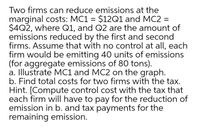Two firms can reduce emissions at the marginal costs: MC1 = $12Q1 and MC2 = $4Q2, where Q1, and Q2 are the amount of emissions reduced by the first and second firms. Assume that with no control at all, each firm would be emitting 40 units of emissions (for aggregate emissions of 80 tons). a. Illustrate MC1 and MC2 on the graph. b. Find total costs for two firms with the tax. Hint. [Compute control cost with the tax that each firm will have to pay for the reduction of emission in b. and tax payments for the remaining emission.
Two firms can reduce emissions at the marginal costs: MC1 = $12Q1 and MC2 = $4Q2, where Q1, and Q2 are the amount of emissions reduced by the first and second firms. Assume that with no control at all, each firm would be emitting 40 units of emissions (for aggregate emissions of 80 tons). a. Illustrate MC1 and MC2 on the graph. b. Find total costs for two firms with the tax. Hint. [Compute control cost with the tax that each firm will have to pay for the reduction of emission in b. and tax payments for the remaining emission.
Oh no! Our experts couldn't answer your question.
Don't worry! We won't leave you hanging. Plus, we're giving you back one question for the inconvenience.
Submit your question and receive a step-by-step explanation from our experts in as fast as 30 minutes.
You have no more questions left.
Message from our expert:
Hi and thanks for your question! Unfortunately we cannot answer this particular question due to its complexity.
We've credited a question back to your account. Apologies for the inconvenience.
Your Question:

Transcribed Image Text:Two firms can reduce emissions at the
marginal costs: MC1 = $12Q1 and MC2 =
$4Q2, where Q1, and Q2 are the amount of
emissions reduced by the first and second
firms. Assume that with no control at all, each
firm would be emitting 40 units of emissions
(for aggregate emissions of 80 tons).
a. Illustrate MC1 and MC2 on the graph.
b. Find total costs for two firms with the tax.
Hint. [Compute control cost with the tax that
each firm will have to pay for the reduction of
emission in b. and tax payments for the
remaining emission.
Recommended textbooks for you


Principles of Economics (12th Edition)
Economics
ISBN:
9780134078779
Author:
Karl E. Case, Ray C. Fair, Sharon E. Oster
Publisher:
PEARSON

Engineering Economy (17th Edition)
Economics
ISBN:
9780134870069
Author:
William G. Sullivan, Elin M. Wicks, C. Patrick Koelling
Publisher:
PEARSON


Principles of Economics (12th Edition)
Economics
ISBN:
9780134078779
Author:
Karl E. Case, Ray C. Fair, Sharon E. Oster
Publisher:
PEARSON

Engineering Economy (17th Edition)
Economics
ISBN:
9780134870069
Author:
William G. Sullivan, Elin M. Wicks, C. Patrick Koelling
Publisher:
PEARSON

Principles of Economics (MindTap Course List)
Economics
ISBN:
9781305585126
Author:
N. Gregory Mankiw
Publisher:
Cengage Learning

Managerial Economics: A Problem Solving Approach
Economics
ISBN:
9781337106665
Author:
Luke M. Froeb, Brian T. McCann, Michael R. Ward, Mike Shor
Publisher:
Cengage Learning

Managerial Economics & Business Strategy (Mcgraw-…
Economics
ISBN:
9781259290619
Author:
Michael Baye, Jeff Prince
Publisher:
McGraw-Hill Education
